Domesticated plants and animals of Austronesia
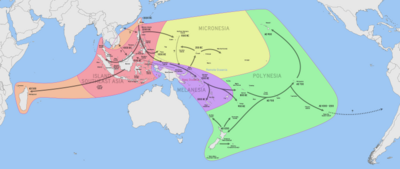
One of the major
They include
Plants
Domesticated, semi-domesticated, and commensal plants carried by Austronesian voyagers include the following:
Aleurites moluccanus (candlenut)

The candlenut (Aleurites moluccanus) was first domesticated in Island Southeast Asia. Remains of harvested candlenuts have been recovered from archaeological sites in Timor and Morotai in eastern Indonesia, dated to around 13,000 BP and 11,000 BP respectively.[10] Archaeological evidence of candlenut cultivation is also found in Neolithic sites of the Toalean culture in southern Sulawesi dated to around 3,700 to 2,300 BP.[11][12] Candlenut were widely introduced into the Pacific Islands by early Austronesian voyagers and became naturalized to high volcanic islands.[13][14][15]
Candlenut has a very wide range of uses and every part of the tree can be harvested. They were primarily cultivated for the high oil content in their nut kernels. They were used widely for illumination, prior to the introduction of other light sources, hence the name "candlenut". The kernels were skewered on coconut midribs that were then set alight. Each kernel takes about three minutes to burn and thus the series could act as a torch. This tradition of making candlenut torches exists in both Southeast Asia and Oceania. Candlenut oil extracted from the nuts can also be used directly in lamps. They can also be utilized in the production of soaps, ointments, and as preservatives for fishing gear. Other traditional uses include using the timber for making small canoes and carvings; the sap for varnish and resins; the nut shells for ornamentation (most notably as leis), fish-hooks, toys, and the production of black dyes; the bark for medicine and fiber; and so on. Some non-toxic varieties are also used as condiments or ingredients in the cuisines of Southeast Asia and the Pacific.[16]
The
Alocasia macrorrhizos (giant taro)

The giant taro (
The reconstructed word for giant taro in
Amorphophallus paeoniifolius (elephant foot yam)

The elephant foot yam (Amorphophallus paeoniifolius) is used as food in Island Southeast Asia, Mainland Southeast Asia, and South Asia. Its origin and center of domestication was formerly considered to be India, where it is most widely utilized as a food resource in recent times. But a genetic study in 2017 has shown that Indian populations of elephant foot yams have lower genetic diversity than those in Island Southeast Asia, therefore it is now believed that elephant foot yams originated from Island Southeast Asia and spread westwards into Thailand and India, resulting in three independent domestication events. From Island Southeast Asia, they were also spread even further west into Madagascar, and eastwards to coastal New Guinea and Oceania by Austronesians. Though they may have spread south into Australia without human intervention.[22][23][24]
The elephant foot yam is one of the four main species of
Artocarpus
Numerous species of

Artocarpus altilis (breadfruit)

According to
The reconstructed
Another notable reconstructed word for breadfruit is Proto-Oceanic *maRi or *mai. It is a common
Artocarpus heterophyllus (jackfruit)
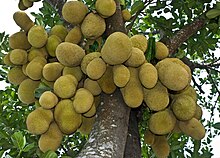
The jackfruit (
Bambusoideae (bamboos)
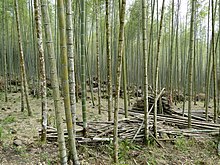
Various species of
Reconstructed Proto-Austronesian words that referred to bamboo include *qauR, *kawayan, *buluq, and *betung. The latter entered
Benincasa hispida (wax gourd)

This section needs expansion. You can help by adding to it. (March 2022) |
Broussonetia papyrifera (paper mulberry)

Paper mulberry (
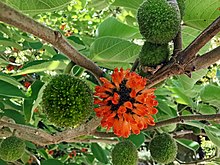
It is believed to be the most widely transported fiber crop in prehistory, having been transported along with the full range of the Austronesian expansion, as opposed to most of the other commensal crops in Oceania. Paper mullbery is present in almost every island or island group in Polynesia, including

Paper mulberry is primarily used in the Pacific Islands to make barkcloth (tapa in most Polynesian languages).[43][44] Barkcloth, can also be made from other members of the mulberry family (Moraceae), including Ficus (figs) and Artocarpus. Barkcloth was also occasionally made from Pipturus nettles, especially in Hawaii. However the highest quality of barkcloth was from paper mulberry.[18]
Barkcloth was mainly used for clothing among ancient Austronesians and is traditionally made using characteristic stone or wooden beaters which are among the most common artifacts found in Austronesian archaeological sites. Numerous archaeological remains of barkcloth beaters in southern China has been regarded as evidence that the pre-Taiwan Austronesian homelands were located in the region prior to the
There are numerous names for paper mulberry throughout Austronesia, the most general can be reconstructed to Proto-Central Eastern Malayo-Polynesian *malaw, which also refers to the
In Eastern Polynesia, terms for paper mulberry can also be reconstructed to Proto-Central Eastern-Polynesian *aute, with cognates including
In most of Polynesia, the term for barkcloth can also be reconstructed from
Calophyllum inophyllum (mastwood)

Mastwood (
Other species of the genus

Various parts of the mastwood were integral to the manufacture of outrigger canoes. The large curving limbs were commonly carved into the
Aside from shipbuilding,
The reconstructed
Another set of cognates for C. inophyllum in Proto-Oceanic can be reconstructed as *tamanu. Its difference from *pitaquR is unclear, but given the distinction between the terms in the
Cananga odorata (ylang-ylang)

Cananga odorata, with its large, aromatic flowers, is used for ornamentation. The species originated from the Philippines.[54] It is not known whether it is native to Polynesia and Melanesia or introduced.[55]
Citrus

Numerous species of Citrus are native to Island Southeast Asia, Mainland Southeast Asia, East Asia, South Asia and Near Oceania. The Austronesians cultivated and gathered a variety of citrus for food, medicine and washing with the thorns being used as piercing implements for
Cocos nucifera (coconut)
The region between

It is most strikingly displayed in
Most words for "coconut" in
Genetic studies of coconuts have also confirmed pre-Columbian populations of coconuts in Panama in South America. However, it is not native and display a genetic bottleneck resulting from a founder effect. A study in 2008 showed that the coconuts in the Americas are genetically closest related to coconuts in the Philippines, and not to any other nearby coconut populations (including Polynesia). Such an origin indicates that the coconuts were not introduced naturally, such as by sea currents. The researchers concluded that it was brought by early Austronesian sailors to the Americas from at least 2,250 BP, and may be proof of pre-Columbian contact between Austronesian cultures and South American cultures, albeit in the opposite direction than what early hypotheses like Heyerdahl's had proposed. It is further strengthened by other similar botanical evidence of contact, like the pre-colonial presence of sweet potato in Oceanian cultures.[62][59][68] During the colonial era, Pacific coconuts were further introduced to Mexico from the Spanish East Indies via the Manila galleons.[57]
In contrast to the Pacific coconuts, Indo-Atlantic coconuts were largely spread by Arab and Persian traders into the East African coast. Indo-Atlantic coconuts were also introduced into the Atlantic Ocean by Portuguese ships from their colonies in coastal India and Sri Lanka; first being introduced to coastal West Africa, then onwards into the Caribbean and the east coast of Brazil. All of these introductions are within the last few centuries, relatively recent in comparison to the spread of Pacific coconuts.[57]
Coix lacryma-jobi (Job's tears)
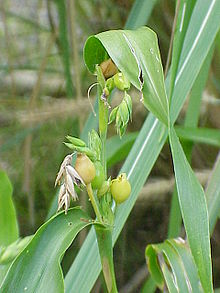
The size and nutrition of Job's tears set it apart from other long-used ancient grains native to this area of Asia, and the well established and recorded use in culinary practices indicate a history at least proportional to that of millet and rice. Dating of a site in Shizitan has presented dates as early as 28,000 to 18,000 years ago.[69] Archaeologists have found evidence supporting Job's tears as among the earliest domesticates in Asia, accompanied by millet.[70]
This section needs expansion. You can help by adding to it. (January 2024) |
Colocasia esculenta (taro)
The taro (
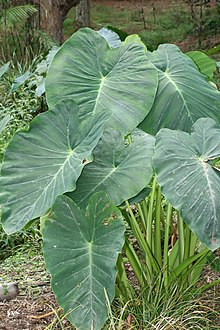
Archaeological traces of taro exploitation have been recovered from numerous sites pre-dating the Austronesian expansion, though whether these were cultivated or wild types can not be ascertained. They include the
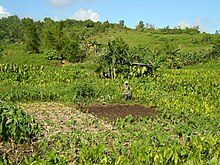
Regardless, taro were definitely among the cultivated plants of Austronesians as well as preceding populations in Island Southeast Asia. However, their importance in Island Southeast Asia had largely been replaced by rice, although they are still planted at the margins of
Taro is also identified as one of the staples of
There are numerous terms for taro in the Austronesian languages, both specific and generalized. The reconstructed Proto-Austronesian term for taro is *cali, with cognates in Formosan languages including Seediq sali, Thao lhari; Bunun tai; and Amis tali.[17]
It became *
In
Cordia subcordata (beach cordia)
The beach cordia (
Beach cordia, like most trees favored by Austronesians, grow well in sandy, clay, and rocky soil and are a common component in coastal forests and mangrove forests. Beach cordia was once thought to be an introduced species, but it is now known to be indigenous to most of the islands and coastlines of the Indo-Pacific, propagated naturally by their buoyant seeds. Nevertheless, they were still deliberately introduced in some islands, with artificial introductions usually found growing with other common trees cultivated by Austronesians. Especially in the atolls of Micronesia.[88][93][94]
Terms for beach cordia is reconstructed to
ganava.Another set of cognates can be reconstructed to
An older reconstructed term is
Cordyline fruticosa (ti)

Ti (

It was carried throughout Oceania by Austronesians, reaching as far as
Ti has many uses but it is most notable as one of the most important plants related to the indigenous
In Polynesia, the leaves of the green-leafed form are used to wrap food, line

In
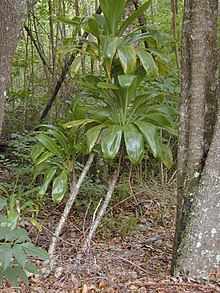
In

In
In Island Melanesia, ti are regarded as sacred by various Austronesian-speaking peoples and are used in rituals for protection, divination, and fertility.[100] Among the Kwaio people, red ti are associated with feuding and vengeance, while green ti are associated with ancestor spirits, markers of sacred groves, and wards against evil. The Kwaio cultivate these varieties around their communities.[129] Among the Maenge people of New Britain, ti leaves are worn as everyday skirts by women. The color and size of leaves can vary by personal preference and fashion. New cultivars with different colors are traded regularly and strands of ti are grown near the village. Red leaves can only worn by women past puberty. Ti is also the most important plant in magic and healing rituals of the Maenge. Some ti cultivars are associated with supernatural spirits and have names and folklore around them.[130] In Vanuatu, Cordyline leaves, known locally by the Bislama name nanggaria, are worn tucked into a belt in traditional dances like Māʻuluʻulu, with different varieties having particular symbolic meanings. Cordylines are often planted outside nakamal buildings.[131] In Fiji, red ti leaves are used as skirts for dancers and are used in rituals dedicated to the spirits of the dead. They are also planted around ceremonial buildings used for initiation rituals.[100]
In Micronesia, ti leaves are buried under newly built houses in Pohnpei to ward off malign sorcery.[122] In instances of an unknown death, shamans in Micronesia communicate with the dead spirit through ti plants, naming various causes of death until the plant trembles.[98] There is also archaeological evidence that the rhizomes of the plants were eaten in the past in Guam prior to the Latte Period.[132]

In Polynesia, green ti were cultivated widely for food and religious purposes. They are commonly planted around homes, in sacred places (including marae and heiau), and in grave sites. The leaves are also carried as a charm when traveling and the leaves are used in rituals that communicate with the species. Like in Southeast Asia, they are widely believed to protect against evil spirits and bad luck; as well as having the ability to host spirits of dead people, as well as nature spirits.[96][98][104]

In
In Aotearoa, certain place names are derived from the use and folklore of ti, like Puketī Forest and Temuka. The ti plants in Kaingaroa are known as nga tī whakāwe o Kaingaroa ("the phantom trees of Kaingaroa"), based on the legend of two women who were turned into ti plants and seemingly follow people traveling through the area.[104]
The reconstructed
In the
Cucumis melo (melon)

This section needs expansion. You can help by adding to it. (January 2024) |
Cyrtosperma merkusii (giant swamp taro)
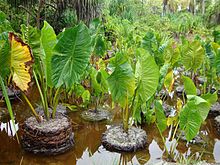
This section needs expansion. You can help by adding to it. (January 2024) |
Dioscorea (yams)
Yams (Dioscorea spp.) is a very large group of plants native throughout tropical and warm temperate regions of the world. Various species of yams were domesticated and cultivated independently within Island Southeast Asia and New Guinea for their starchy tubers, including the ube (Dioscorea alata), round yam (Dioscorea bulbifera), intoxicating yam (Dioscorea hispida), lesser yam (Dioscorea esculenta), Pacific yam (Dioscorea nummularia), fiveleaf yam (Dioscorea pentaphylla), and pencil yam (Dioscorea transversa).[137] Among these, D. alata and D. esculenta were the only ones regularly cultivated and eaten, while the rest were usually considered as famine food due to their higher levels of the toxin dioscorine which requires that they be prepared correctly before consumption.[138]
D. alata and D. esculenta were the most suitable for long transport in Austronesian ships and were carried through all or most of the range of the Austronesian expansion. D. alata in particular, were introduced into the Pacific Islands and New Zealand. They were also carried by Austronesian voyagers into Madagascar and the Comoros.[63][139][140]
Dioscorea alata (ube)

The ube (

Based on archaeological evidence of early farming plots and plant remains in the Kuk Swamp site, authors have suggested that it was first domesticated in the highlands of New Guinea from around 10,000 BP and spread into Island Southeast Asia via the Lapita culture at around c. 4,000 BP, along with D. nummularia and D. bulbifera. In turn, D. esculenta is believed to have been introduced by the Lapita culture into New Guinea. There is also evidence of an agricultural revolution during this period brought by innovations from contact with Austronesians, including the development of wet cultivation.[73][145]

However, much older remains identified as being probably D. alata have also been recovered from the
Ube remains an important crop in Southeast Asia. Particularly in the Philippines where the vividly purple variety is widely used in various traditional and modern desserts. It also remains important in Melanesia, where it is also grown for ceremonial purposes tied to the size of the tubers at harvest time. Its importance in eastern Polynesia and New Zealand, however, has waned after the introduction of other crops, most notably the sweet potato.[141]
The reconstructed
Among
In some ethnic groups, the word has been generalized or shifted to mean other types of yams, as well as the sweet potato and cassava. Other words for ube are also derived from the ancestral names of other species of yam.[141][17]
Dioscorea bulbifera (air yam)

The air yam (Dioscorea bulbifera), also known as the bitter yam, is one of the lesser cultivated species of yam. It is usually only eaten as famine food in Island Southeast Asia, Melanesia, and Polynesia, because of the toxicity of some wild or feral plants when not cooked correctly. However it is one of only three yams that were carried by Austronesians into Remote Oceania, the others being D. alata and D. nummularia. The part of the plant harvested are the aerial tubers, as it does not usually produce large underground tubers.[23][149]
It can be reconstructed to
Dioscorea esculenta (lesser yam)

The lesser yam (Dioscorea esculenta) is the second most important yam crop among Austronesians. Like D. alata, it requires minimal processing, unlike the other more bitter yam species. However, it has smaller tubers than D. alata and is usually spiny.[150] Like D. alata it was introduced to Madagascar and the Comoros by Austronesians, where it spread to the East African coast.[151][139][152] They are also a dominant crop in Near Oceania, However, it did not reach to the furthest islands in Polynesia, being absent in Hawaii and New Zealand.[153][154][155]
Starch grains identified to be from the lesser yam have been recovered from archaeological sites of the
Terms for lesser yam in Austronesian languages are mostly affixed or two-word forms derived from the *qubi root for D. alata, like
Dioscorea hispida (intoxicating yam)
The intoxicating yam (
Ficus (fig trees)
Ficus is a genus of about 850 species of woody trees, shrubs, vines, epiphytes and hemiepiphytes of the family Moraceae, which are collectively known as fig trees or figs. These plants are native to the tropics, with some species extending into the semi-warm temperate zone. Despite not being a genus exclusive to the Austronesian regions, several species such as ficus dammaropsis, ficus fistulosa, ficus hispida, ficus nota, ficus pseudopalma, ficus septica, ficus variegata, ficus aspera, ficus fraseri, ficus tinctoria, ficus ulmifolia, ficus wassa, ficus mutabilis, ficus deltoidea, ficus nota and ficus pseudopalma are endemic to these regions, and played an important role in Austronesian cultures.[162][163][164][165][166][167][168][169][170][171][172][173]
Ficus aspera

Ficus aspera, also known as mosaic fig, is a plant native to Vanuatu, in the South Pacific region. The fruits of this plant are cauliflowerous (fruits that form from their main stems or woody trunks instead of new shoots). The mosaic fig is used as an ornamental plant.[170][174]
Ficus dammaropsis
Ficus dammaropsis, known as kapiak in
Ficus fraseri
Ficus fraseru, also known as white sandpaper fig and bright sandpaper fig is one of several species of figs known as paper figs' sandpaper . This fig is native to New South Wales, Queensland, and Northern New Caledonia and Vanuatu. This fig grows as a bush or as a tree, with a height that varies between 6 and 15 meters. Its leaves are 6 to 14 cm long and 2.5 to 6.5 cm wide on petioles 1 to 2 cm long. The rounded figs are 1 to 1.5 cm long and start out yellow, maturing to orange-red between May and February in the species' native range. These are edible but tasteless.[176][171][177][178] Although rarely seen in cultivation, it is a fast growing ornamental species. It can be easily propagated from seeds.
Ficus nota

Ficus nota, is a species of flowering plant known as tibig, found near water at low altitudes. The tibig is native to the Philippines. They are also found in parts of northern Borneo, in Malaysia. The tree can grow up to 9 meters high.
The fruits are also edible for humans, although they are quite tasteless. They are usually eaten with sugar and cream in the Philippines. The raw leaves are also eaten as a vegetable.[179][180][181]
Ficus pseudopalma
Ficus pseudopalma, is a species of fig commonly known as Philippine fig, Philippine fig, dracaena fig or palm leaf fig' . This is an endemic species of Philippines, especially the island of Luzon.[182][183]
This is a bush that grows erect with a bare, branchless stem topped with a clump of leaves that give it the appearance of a palm tree (hence the term pseudopalma in its name, meaning "false palm"). The fruit is a dark green fig that grows in pairs, each fruit just over an inch long.[184]
In Luzon, this plant is found in grassland and forest habitats, where it is considered common. The shoots of this plant are consumed as a type of vegetable, and there are several traditional uses; among these is its use as a remedy for
Ficus tinctoria
Ficus tinctoria, also known as coloring fig or hunchback fig, is a tree belonging to one of the species known as strangler figs. This is found in Malaysia, northern Australia and the islands of the South Pacific.
Palms are favorable host species. The root systems of the coloring fig can join to be self-supporting, but the epiphyte usually drops if the host tree dies or rots. The small rust-brown fruit of the dye fig is the source of a red dye used in traditional fabric making in parts of Oceania and Indonesia. The fruit is also edible and an important food source in the low-lying atolls of Micronesia and Polynesia.[187][188]
Ficus variegata
Ficus variegata, is a species of tropical fig found in various parts of Asia, Pacific islands and southeastern Australia. There are several names for this species, such as common red-stemmed fig, green-fruited fig and variegated fig.[169][168]
Ipomoea batatas (sweet potato)
Lagenaria siceraria (bottle gourd)
Morinda citrifolia (noni)

Noni (Morinda citrifolia) is native to Southeast Asia extending to New Guinea and northern Australia. It grows readily in beach and rocky environments. It has been introduced widely into the Pacific. All parts of the plant were used by Austronesians for traditional medicine and timber, but its most common traditional use is for the extraction of red or yellow dyes. The odor of the plant and the fruit was also traditionally believed to repel evil spirits. The fruit is also edible, but is usually only eaten as famine food.[189]
There are several terms for noni that can be reconstructed. The most widespread is
In
There are also smaller cognate sets, like
Musa (bananas)
The earliest domestication of
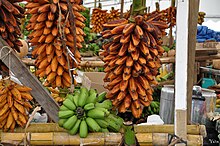
These ancient introductions resulted in the banana subgroup now known as the
A second wave of introductions later spread bananas to other parts of
Musa abaca (abacá)
Musa × troglodytarum (fe'i banana)
Fe'i bananas (Musa × troglodytarum), also spelled Fehi or Féi, are banana cultivars unique to Melanesia, the Maluku Islands, and Polynesia. Unlike other domesticated banana cultivars which are derived from Musa acuminata and Musa balbisiana, fe'i bananas are believed to be hybrids derived from entirely different species. Proposed progenitors of fe'i bananas include Musa jackeyi, Musa lolodensis, Musa maclayi, and Musa peekelii, all of which are native to New Guinea and surrounding islands. Like other bananas, they were spread eastwards to Polynesia for use as food. However, they are absent in Island Southeast Asia, reaching only as far as the Maluku Islands.[192]
Oryza sativa (rice)
(8,500 to 1,500 BCE)
Rice (
There are two most likely centers of domestication for rice as well as the development of the

The second is in the middle Yangtze River, believed to be the homelands of the early
The spread of japonica rice cultivation to Southeast Asia started with the migrations of the Austronesian Dapenkeng culture into Taiwan between 5,500 and 4,000 BP. The Nanguanli site in Taiwan, dated to ca. 4,800 BP, has yielded numerous carbonized remains of both rice and millet in waterlogged conditions, indicating intensive wetland rice cultivation and dryland millet cultivation.[193]
From about 4,000 to 2,500 BP, the
However, rice (as well as dogs and pigs) did not survive the first Austronesian voyages into
The Lapita culture also came into contact with the non-Austronesian (
Rice, along with other Southeast Asian food plants, were also later introduced to Madagascar, the Comoros, and the coast of East Africa by around the 1st millennium CE by Austronesian sailors from the Greater Sunda Islands.[139]
Much later Austronesian voyages from Island Southeast Asia succeeded in bringing rice to Guam during the Latte Period (1,100 to 300 BP). Guam is the only island in Oceania where rice was grown in pre-colonial times.[200][201]
Pandanus (pandan)
Pandanus (
Pandanus were also profoundly crucial in enabling the
The word for pandanus in

Pandanus grow well in island habitats, being very salt-tolerant and easy to propagate, making them ideal plants for early Austronesian sailors. Like coconuts, they grow predominantly along

Pandanus tectorius in Oceania show evidence of long cultivations, with hundreds of different
Very old fossils of Pandanus tectorius have been recovered from Hawaii, dated to more than 1.2 million years old. This indicates that the plants once colonized Hawaii (and likely the rest of the Pacific islands) naturally through their buoyant fruits. However, useful domesticated varieties were carried by Austronesians from island to island. Especially since wild pandanus have calcium oxalate crystals (raphides) in their fruit tissue. They cause itchiness and irritation when eaten raw and thus need to be cooked. Domesticated varieties which have less raphides (which are also usually less fibrous and more nutritious), were therefore valued . It is thus considered both native and introduced.[207][203] There are also fossil evidence of pandanus fruits being harvested for food in New Guinea from archaeological sites dated to around 34,000 to 36,000 BP.[203]
Other important species of pandanus utilized by Austronesians include
Piper (peppers)
Peppers (
Piper betle (betel)

The betel (

Based on archaeological, linguistic, and botanical evidence, betel chewing is most strongly associated with Austronesian cultures, despite its widespread adoption by neighboring cultures in prehistoric and historic times. The original range of betel is unknown, but Areca catechu is known to be originally native to the
The oldest unequivocal evidence of betel chewing is from the
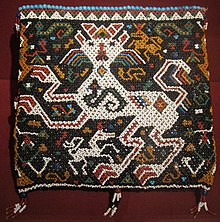
It reached
The practice also diffused to the cultures the Austronesians had historical contact with. It reached
There are very old claims of betel chewing dating to at least 13,000 BP at the Kuk Swamp site in New Guinea, based on probable Areca sp. recovered. However, it is now known that these might have been due to modern contamination of sample materials. Similar claims have also been made at other older sites with Areca sp. remains, but none can be conclusively identified as A. carechu and their association with betel peppers is tenuous or nonexistent.[211]
There are numerous cognate sets reconstructible in Austronesian languages relating to various aspects of betel chewing. Ranging from chewing something without swallowing to equipment used to climb areca nut palms to the betel spittle. One cognate set that can be reconstructed for betel pepper is
Two other cognate sets reached into Oceania. The first is Proto-Malayo-Polynesian *pu-pulu, which became Proto-Oceanic *[pu-]pulu. Cognates include
Piper cubeba (cubeb pepper)
The cubeb pepper (
Piper excelsum (kawakawa)
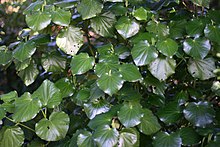
Kawakawa (
However, kawakawa's resemblance to true kava is only superficial. Kawakawa roots do not have psychoactive properties. Instead, kawakawa's primary use is for traditional medicine.[222]
Piper methysticum (kava)
Kava (


It was spread by Austronesians after contact into the rest of
Consumption of kava is also believed to be the reason why
According to Lynch (2002), the reconstructed
In the
Piper retrofractum (Javanese long pepper)
The Javanese long pepper (
Saccharum (sugarcane)
There are two centers of domestication for

Saccharum officinarum was first domesticated in
The second domestication center is mainland southern China and Taiwan where S. sinense (though other authors identify it as S. spontaneum) was one of the original major crops of the
The reconstructed word for "sugarcane" in
Solanum

Several species of Solanum have been utilised as food and medicine by the Austronesian people. Species cultivated include Kangaroo apple (Solanum aviculare), poroporo (Solanum laciniatum), Indian nightshade (Solanum lasiocarpum), pacific tomato (Solanum repandum) and cannibals tomato (Solanum viride).
Syzygium
Trees in the genus
Syzygium malaccense (mountain apple)
The mountain apple (
They were valued primarily for their abundant edible fruits. It is also used for timber (usually for building houses) and parts of the trees are used in traditional medicine. The attractive flowers are also worn as personal hair adornments and in making
There numerous names for mountain apples in Austronesian languages. In the Philippines, the terms can be reconstructed to
In Oceania, there are several cognate sets reconstructible for mountain apples and related species. Four of which are *pokaq, *marisapa, *sakau and *cay, with limited
Tacca leontopetaloides (Polynesian arrowroot)
Polynesian arrowroot (Tacca leontopetaloides) is another ancient Austronesian root crop closely related to yams. It is originally native to Island Southeast Asia. It was introduced throughout the entire range of the Austronesian expansion, including Micronesia, Polynesia, and Madagascar. Polynesian arrowroot have been identified as among the cultivated crops in Lapita sites in Palau, dating back to 3,000 to 2,000 BP.[235] It was also introduced to Sri Lanka, southern India, and possibly also Australia through trade and contact.[236]
Polynesian arrowroot was a minor staple among Austronesians. The roots are bitter if not prepared properly, thus it was only cultivated as a secondary crop to staples like
The names for Polynesian arrowroot in
Derivations from Proto-Malayo-Polynesian *sagu ("sago palm"), include
Talipariti tiliaceum (sea hibiscus)
Sea hibiscus (
The wood is soft and not very durable, so it is mostly only used for products like carvings, spears, bowls, and bracelets. However, it is also resistant to saltwater and thus can be used to make small canoes and outriggers. The wood is also preferred for
The terms for beach hibiscus can be reconstructed to
In addition, there are numerous terms relating to the use of sea hibiscus for cordage and fiber in various Austronesian languages which can be traced back to Proto-Malayo-Polynesian or Proto-Austronesian, like *Calis, "rope".[17]
Thespesia populnea (Pacific rosewood)
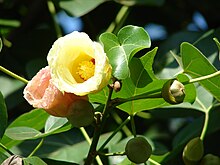
The Pacific rosewood (
The trees were regarded as sacred in Polynesian culture, and were commonly planted in marae sites along with trees like Ficus, Fagraea berteroana, Casuarina equisetifolia and Calophyllum inophyllum.[238][239]
The terms for Pacific rosewood can be reconstructed to Proto-Malayo-Polynesian *balu, with cognates including
In Eastern Polynesia, most modern names can be reconstructed back to Proto-Eastern Oceanic *milo, with cognates including
Zingiberaceae (ginger family)
Gingers (
Alpinia galanga (lengkuas)
The lengkuas (Alpinia galanga) is native to Southeast Asia. Its original center of cultivation during the spice trade was Java, and today it is still cultivated extensively in Island Southeast Asia, most notably in the Greater Sunda Islands and the Philippines. It is valued for its use in food and for traditional medicine and is regarded as being superior to ginger. It has a pungent smell reminiscent of black pepper. The red and white cultivars are often used differently, with the red cultivars being primarily medicinal, and the white cultivars being primarily a spice.[152][243] Lengkuas is also the source of the leaves used to make nanel among the Kavalan people of Taiwan, a rolled leaf instrument used as a traditional children's toy common among Austronesian cultures.[244]
Lengkuas can be reconstructed to Proto-Western Malayo-Polynesian *laŋkuas, with cognates including
Curcuma longa (turmeric)

There is strong evidence that turmeric (

The plant is important in the Philippines and Indonesia as a traditional

There are two main
The other cognate set is derived from reconstructed
In

Zingiber officinale (ginger)
Ginger (
In
The terms for ginger beyond Taiwan can be reconstructed to
Zingiber zerumbet (bitter ginger)

Bitter ginger (Zingiber zerumbet) is native to tropical Asia and Australasia. Like the ginger, was carried by Austronesian settlers all the way to Remote Oceania during prehistoric times. Thus it is likely that it was originally domesticated by Austronesians. Remains of bitter ginger have also been identified from the Kuk Swamp archaeological site in New Guinea at the Phase 1 layers dated to 10,220 to 9,910 BP. However, whether they were cultivated or simply exploited from the wild is unknown.[249][224]
Bitter ginger is primarily used for traditional medicine. It also has mildly psychoactive properties when consumed, and thus had ritual importance among early Austronesian cultures. According to Lynch (2002), terms for bitter ginger in the sense of "bitter root" or "potent root [used as
Some
In non-Oceanic languages, terms for bitter ginger can be reconstructed to Proto-Western Malayo-Polynesian *lampuyaŋ, with cognates including
Animals
Domesticated, semi-domesticated, and commensal animals carried by Austronesian voyagers include the following:
Bubalus bubalis (water buffalo)

The earliest remains of water buffaloes in Island Southeast Asia with signs of domestication comes from multiple fragmentary skeletal remains recovered from the upper layers of the
The
However, it is also clear that
Other native names for carabaos include
Bos javanicus domesticus (Bali cattle)
Bali cattle were domesticated in Bali from the wild banteng around 3500 BCE.
Canis lupus familiaris (dog)
Dogs were primarily valued for their social functions in various Austronesian cultures, acting as companions and pets. They were also trained to be hunting or guard dogs. Ornaments made from dog fur, teeth, and bones are found in archaeological sites throughout Austronesia. These could be traded as commodities, along with dog pups. Dogs were also sometimes eaten, but this varies by culture, with most groups refusing to eat dogs, while in others they were apparently a main food source.[260][261][262][263][264]

The origins of the dog (
Regardless, most authors agree that there were at least two introduction events. One arriving with


The Neolithic introductions are believed to have partially replaced the original introductions and became the ancestors of the modern village dogs of Southeast Asia. Unlike the first wave, they have adaptations that enable them to digest starch, indicating that they accompanied cultivators of
The oldest archaeological remains of dogs in Island Southeast Asia and Oceania is a dog burial in Timor and dingo remains in Australia, both of which are dated to around 3,500 BP. The former are believed to have been part of the second wave and the latter from the first wave.[262][266][264]
From Island Southeast Asia, they were carried by Austronesian voyagers into
On certain Pacific islands, settlers did not bring dogs, or the dogs died out after original settlement, notably: the
Dogs were not introduced to Madagascar by Austronesians. A genetic study by Ardalan et al. (2015) revealed that the dog population in Madagascar were all derived solely from African dog populations and did not come from Southeast Asian dog populations. This aberrant origin is also reflected in the
Gallus gallus (chicken)
Sus scrofa domesticus (pig)
Rodentia (rodents)
The following rodent species are common in mainland Southeast Asia, but are restricted to areas of wet rice cultivation in western Indonesia (Sumatra and Java).[278]
Mus caroli
Mus cervicolor
Rattus argentiventer
Bandicota bengalensis
The following two rodents are native to South Asia and also present in western Indonesian rice fields, so their presence in
Mus terricolor (also known as Mus dunni)
Indigenous to northwestern India
Rattus nitidus (indigenous to Nepal)
Rattus exulans)
This rat originated on the island of Flores in Indonesia.[279] Polynesians accidentally or deliberately introduced it to the islands they settled. This rat has been implicated in many of the extinctions of native birds and insects in the Pacific; these species had evolved in the absence of mammals and could not cope with predation by the rat.
See also
- Agriculture in Papua New Guinea
- Catamaran
- Crab claw sail
- Domesticated plants of Mesoamerica
- Genomics of domestication
- History of agriculture
- List of food origins
- Outrigger canoe
- Proto-Oceanic language § Lexicon
- Tanja sail
References
- ISBN 978-0470016176.
- ISBN 9780415297776.
- ISBN 9781442213869.
- ISBN 9780521644327.
- ISBN 9781921536618.
- ^ S2CID 36818517.
- ^ W. Arthur Whistler (1991). "Islands, Plants, and Polynesians—An Introduction to Polynesian Ethnobotany." National Tropical Botanical Garden c/o Botany Department University of Hawaii Honolulu, Hawaii 96822. Retrieved March 2022.
- ISBN 9781921862489.
- ^ Theroux, Paul (December 2002). "The Hawaiians". National Geographic. 202 (6): 2–41.
- ^ a b c Blench, Roger (2004). "Fruits and arboriculture in the Indo-Pacific region". Bulletin of the Indo-Pacific Prehistory Association. 24 (The Taipei Papers (Volume 2)): 31–50.
- ISBN 9789792624991.
- S2CID 134786275.
- S2CID 28192073.
- ^ Weisler, Marshall I.; Mendes, Walter P.; Hua, Quan (2015). "A prehistoric quarry/habitation site on Moloka'i and a discussion of an anomalous early date on the Polynesian introduced candlenut (kukui, Aleurites moluccana)". Journal of Pacific Archaeology. 6 (1): 37–57.
- S2CID 29664192.
- ISBN 9780970254450.
- ^ S2CID 146739541.
- ^ .
- PMID 22209857.
- ^ Manner, Harley I. (2006). "Farm and Forestry Production Marketing Profile for Giant Tao (Alocasia macrorrhiza)" (PDF). In Elevitch, Craig R. (ed.). Specialty Crops for Pacific Island Agroforestry. Permanent Agricultural Resource (PAR).
- ^ S2CID 84341068.
- PMID 28658282.
- ^ .
- S2CID 128880569.
- ^ ISBN 9780473288730.
- ^ ISBN 9789048186617.
- ^ Orwa, C.; Mutua, A.; Kindt, R.; Jamnadass, R.; Anthony, S. (2009). Artocarpus heterophyllus (PDF). Agroforestree Database:a tree reference and selection guide v.4.0. World Agroforestry.
- ISBN 9780128031384.
- ^ Orwa, C.; Mutua, A.; Kindt, R.; Jamnadass, R.; Anthony, S. (2009). Artocarpus lakoocha (PDF). Agroforestree Database:a tree reference and selection guide v.4.0. World Agroforestry.
- ^ Orwa, C.; Mutua, A.; Kindt, R.; Jamnadass, R.; Anthony, S. (2009). Artocarpus mariannensis (PDF). Agroforestree Database:a tree reference and selection guide v.4.0. World Agroforestry.
- ISBN 9780128031384.
- ^ Madulid, Domingo A. (6 August 2011). "Artocarpus treculianus". Philippine Native Plants. The Philippine Star. Retrieved 14 January 2019.
- ^ a b Ragone, Diane (2006). "Artocarpus camansi (breadnut)" (PDF). In Elevitch, Craig R. (ed.). Species Profiles for Pacific Island Agroforestry. Permanent Agriculture Resources (PAR).
- PMID 21653430.
- PMID 26499243.
- ^ a b "*Kulu". Te Mära Reo: The Language Garden. Benton Family Trust. Retrieved 15 January 2019.
- JSTOR 3623057.
- ^ Hull, Geoffrey (2000). "Historical phonology of Tetum". Studies in Languages and Cultures of East Timor. 3 (2000): 158–212.
- ^ ISBN 9784902325331.
- ^ a b "*Kofe". Te Mära Reo: The Language Garden. Benton Family Trust. Retrieved 15 January 2019.
- ISBN 9780759100336.
- S2CID 37057768.
- ^ PMID 26438853.
- ^ S2CID 83993320.
- S2CID 54664583.
- .
- ^ "*Aute". Te Mära Reo: The Language Garden. Benton Family Trust. Retrieved 15 January 2019.
- ^ a b c Orwa, C.; Mutua, A.; Kindt, R.; Anthony, S. (2009). "Calophyllum inophyllum" (PDF). Agroforestree Database:a tree reference and selection guide version 4.0. World Agroforestry.
- ^ ISBN 9781785332333.
- ^ S2CID 21847865. Archived from the original(PDF) on 19 January 2019. Retrieved 17 January 2019.
- ISBN 9781591200161.
- ^ Allen, James A. (2002). "Calophyllum inophyllum" (PDF). In Vozzo, J.A. (ed.). Tropical Tree Seed Manual. Agriculture Handbook. Vol. 721. US Department of Agriculture Forest Service. pp. 357–359.
- ISBN 9783110884012.
- ^ "Cananga odorata (Lam.) Hook.f. & Thomson". Plants of the World Online. Royal Botanic Gardens, Kew. Retrieved 11 February 2019.
- ISBN 978-0-520-25649-1.
- ^ Blench, R.M. (2005). "Fruits and arboriculture in the Indo Pacific region". Bulletin of the Indo-Pacific Prehistory Association. 24: 31–50.
- ^ PMID 21731660.
- ^ Lutz, Diana (24 June 2011). "Deep history of coconuts decoded". The Source. Retrieved 10 January 2019.
- ^ a b Brouwers, Lucas (1 August 2011). "Coconuts: not indigenous, but quite at home nevertheless". Scientific American. Retrieved 10 January 2019.
- ISBN 9780387775937. Archived from the originalon 20 April 2016.
- ^ Chan, Edward; Elevitch, Craig R. (2006). "Cocos nucifera (coconut)" (PDF). In Elevitch, Craig R. (ed.). Species Profiles for Pacific Island Agroforestry. Permanent Agriculture Resources (PAR).
- ^ S2CID 19529408.
- ^ PMID 27247383.
- ^ Blust, Robert (1988). "The Austronesian Homeland: A Linguistic Perspective" (PDF). Asian Perspectives. 26 (1): 45–67.
- ^ Elbert, Samuel H. (1964). "Hawaiian reflexes of Proto-Malayo-Polynesian and Proto-Polynesian reconstructed forms". The Journal of the Polynesian Society. 73 (4): 399–410. Archived from the original on 27 September 2021. Retrieved 15 January 2019.
- S2CID 144931249.
- ^ Ahuja, S.C.; Ahuja, Siddharth; Ahuja, Uma (2014). "Coconut – History, Uses, and Folklore" (PDF). Asian Agri-History. 18 (3): 221–248. Archived from the original (PDF) on 10 August 2017.
- JSTOR 2845766.
- ISSN 1040-6182– via Science Direct.
- ISSN 0959-6836.
- S2CID 21917510.
- ISBN 9781845936211.
- ^ PMID 27314588.
- ^ Matthews, Peter J.; Nguyen, Van Dzu; Tandang, Daniel; Agoo, E. Maribel; Madulid, Domingo A. (2015). "Taxonomy and ethnobotany of Colocasia esculenta and C. formosana (Araceae): implications for the evolution, natural range, and domestication of taro". Aroideana. 38E (1). Archived from the original on 19 January 2019. Retrieved 18 January 2019.
- ISBN 9784901906937. Archived from the original(PDF) on 19 January 2019. Retrieved 18 January 2019.
- ^ S2CID 131187696. Archived from the original(PDF) on 19 January 2019. Retrieved 18 January 2019.
- ^ doi:10.5334/pia.308.
- .
- S2CID 128780288.
- S2CID 162663964.
- ISBN 9781902937588.
- .
- ^ "Ancient Chamorro Agricultural Practices". Guampedia. 10 February 2011. Retrieved 18 January 2019.
- ^ Dixon, Boyd; Walker, Samuel; Golabi, Mohammad H.; Manner, Harley (2012). "Two probably latte period agricultural sites in northern Guam: Their plants, soils, and interpretations" (PDF). Micronesica. 42 (1/2): 209–257.
- ^ "talas". Malay Literary Reference Centre. Kuala Lumpur: Dewan Bahasa dan Pustaka. Archived from the original on 3 June 2021. Retrieved 22 May 2022.
- ISBN 9789790691254. Archived from the original(PDF) on 19 August 2021.
- ^ "*Talo/Taro". Te Mära Reo: The Language Garden. Benton Family Trust. Retrieved 18 January 2019.
- ^ a b c Friday, J.B.; Okano, Dana (2006). "Cordia subcordata (kou)" (PDF). In Elevitch, Craig R. (ed.). Species Profiles for Pacific Island Agroforestry. Permanent Agriculture Resources (PAR).
- ISBN 9781925021264.
- ^ Sudarmin, M.Si; Pujiastuti, Sri Endang (2015). "Scientific Knowledge Based Culture and Local Wisdom in Karimunjawa for Growing Soft Skills Conservation" (PDF). International Journal of Science and Research. 4 (9): 598–604.
- ^ Boerger, Brenda H. (2009). "Trees of Santa Cruz Island and their Metaphors" (PDF). Proceedings of the Seventeenth Annual Symposium About Language and Society, Austin. Texas Linguistic Forum. Vol. 53. pp. 100–109. Archived from the original (PDF) on 21 September 2021. Retrieved 18 January 2019.
- ^ Kahn, Jennifer G.; Coil, James H. (2006). "What House Posts Tell Us about Status Difference in Prehistoric Society: An Interpretation of Charcoal Analysis, Sacred Woods and Inter-site Variability" (PDF). The Journal of the Polynesian Society. 115 (4): 319–352. Archived from the original (PDF) on 23 October 2023. Retrieved 18 January 2019.
- ISBN 9781921313905.
- S2CID 161160463.
- ISBN 9780824831349.
- ^ PMID 21636452.
- ^ Philip, Simpson (9 September 2012). "Cordyline fruticosa (ti plant)". Invasive Species Compendium. Centre for Agriculture and Bioscience International. Retrieved 19 January 2019.
- ^ a b c d Hinkle, Anya E. (2004). "The distribution of a male sterile form of ti (Cordyline fruticosa) in Polynesia: a case of human selection?" (PDF). The Journal of the Polynesian Society. 113 (3): 263–290. Archived from the original (PDF) on 5 July 2022. Retrieved 19 January 2019.
- ^ Trisha, Borland (2009). "Cordyline fruticosa: the distribution and continuity of a sacred plant" (PDF). UCB Moorea Class: Biology and Geomorphology of Tropical Islands. Student Research Papers, Fall 2009. University of California.
- ^ a b c d e f g h Ehrlich, Celia (2000). "'Inedible' to 'edible': Firewalking and the ti plant [Cordyline fruticosa (L.) A. Chev.]". The Journal of the Polynesian Society. 109 (4): 371–400. Archived from the original on 1 December 2019. Retrieved 21 January 2019.
- ^ Ehrlich, Celia (1989). "Special problems in an ethnobotanical literature search: Cordyline terminalis (L.) Kunth, the "Hawaiian ti plant"" (PDF). Journal of Ethnobiology. 9 (1): 51–63.
- ^ ISBN 9781478610021.
- .
- ^ .
- Eater. Retrieved 21 January 2019.
- ^ Griffith, Robert Eglesfeld (1847). Medical Botany. Lea and Blanchard. p. 655.
- ^ van Schooneveld, Inge (18 July 2018). "Punnuk rice harvest ritual celebrates the Earth's abundance". Sinchi. Retrieved 19 January 2019.
- ^ de Guzman, Daniel (6 July 2018). "Flora De Filipinas: A Short Overview of Philippine Plant Lore". The Aswang Project. Retrieved 19 January 2019.
- ^ Harvest Rituals in Hapao (PDF). Social Practices, Rituals and Festive Events. International Information and Networking Centre for Intangible Cultural Heritage in the Asia-Pacific Region under the auspices of UNESCO (ICHCAP). Archived from the original (PDF) on 9 September 2018. Retrieved 19 January 2019.
- .
- ^ Novellino, Dario (2001). "Palawan Attitudes Toward Illness" (PDF). Philippine Studies. 49 (1): 78–93.
- ^ Gunawan (2013). "Study Ethnobotany Andong Plants of the Genus Cordyline in the Dayaknese of Meratus Lok Lahung Village, Loksado, South Borneo". 4th International Conference on Global Resource Conservation & 10th Indonesian Society for Plant Taxonomy Congress. Brawijaya University. Archived from the original on 26 January 2020. Retrieved 19 January 2019.
- ^ a b Rahayu, Mulyati; Rustiami, Himmah; Rugayah (2016). "Ethnobotanical Study of Sasak Ethnic, East Lombok, West Nusa Tenggara" (PDF). Journal of Tropical Biology and Conservation: 85–99.
- .
- ^ Hakim, Nurul (2006). Cultural and Spiritual Values of Forests in Bady Region, Banten, Indonesia. MSc Forest and Nature Conservation Policy. Wageningen University.
- .
- ISBN 9789004274075.
- ^ Sumantera, I. Wayan (1999). "Plants Intertwined with Culture". Roots. 1 (19). Archived from the original on 19 January 2019. Retrieved 19 January 2019.
- ISBN 9789401771504.
- ISBN 9780252011832.
- ISBN 9781920942847.
- ^ .
- ISBN 9780822388067.
- ISBN 9780521852418.
- JSTOR 3772735.
- .
- ^ Hill, Rowena Catherine (2011). Colour and Ceremony: the role of paints among the Mendi and Sulka peoples of Papua New Guinea (MSc). Durham University.
- ISBN 9781921666018.
- S2CID 143871873.
- ISBN 9782956398189.
- ISBN 9780956098542.
- ^ a b Moore, Darlene R. (2005). "Archaeological Evidence of a Prehistoric Farming Technique on Guam" (PDF). Micronesica. 38 (1): 93–120.
- ^ Kawate, M.; Uchida, J.; Coughlin, J.; Melzer, M.; Kadooka, C.; Kam, J.; Sugano, J.; Fukuda, S. (2014). "Ti Leaf (Cordyline terminalis or fruticosa) Diseases in Hawaii's Commercial Orchards" (PDF). HānaiʻAi/The Food Provider: 1–11. Archived from the original (PDF) on 10 December 2015. Retrieved 21 January 2019.
- ^ Gamayo, Darde (4 August 2016). "Ti Leaf: Canoe Plant of Ancient Hawai'i". Big Island Now. Retrieved 21 January 2019.
- ^ Da Silva, Alexandre (24 July 2005). "Thrill ride". Star Bulletin. Retrieved 21 January 2019.
- ^ a b "*Tï". Te Mära Reo: The Language Garden. Benton Family Trust. Retrieved 15 January 2019.
- ^ .
- .
- ^ S2CID 55763047.
- ISBN 9781863204705.
- ^ a b c d e "*Qufi ~ Uwhi, uhi". Te Mära Reo: The Language Garden. Benton Family Trust. Retrieved 21 January 2019.
- S2CID 35381460.
- ^ Cruz, V.M.V.; Altoveros, N.C.; Mendioro, M.S.; Ramirez, D.A. (1999). "Geographical patterns of diversity in the Philippine edible yam collection". Plant Genetic Resources Newsletter. 119: 7–11.
- doi:10.7152/bippa.v18i0.11710 (inactive 7 February 2024).)
{{cite journal}}: CS1 maint: DOI inactive as of February 2024 (link - ^ ISBN 9781760461164.
- S2CID 11596542.
- ISBN 9781902937588. Archived from the original(PDF) on 28 March 2019. Retrieved 21 January 2019.
- ISBN 9781902937540.
- ^ "Dioscorea bulbifera – Air Yam". Hawaiian Plants and Tropical Flowers. 5 November 2012. Retrieved 21 January 2019.
- ISBN 9780123948076.
- ISBN 9781902937526.
- ^ ISBN 9788173049866.
- ISBN 9780521788793.
- S2CID 85828982.
- ^ White, Lynton Dove. "Uhi". Na Meakanu o Wa'a o Hawai'i Kahiko: The "Canoe Plants" of Ancient Hawai'i. Retrieved 21 January 2019.
- .
- .
- ISBN 9780858835627.
- ISBN 9781760460952.
- ^ "Root Crops: Yam". Retrieved 25 July 2021.
- .
- S2CID 208557447.
- ^ "Plants of the World Online". Retrieved 8 April 2019.
- ^ "Ficus hispida". ZipcodeZoo. Archived from the original on 30 August 2010. Retrieved 17 April 2012.
- ^ "Biotik.org". Ficus hispida. Archived from the original on 25 July 2010. Retrieved 17 April 2012.
- ^ "Ficus nota (Blanco) Merr". Plants of the World Online. The Trustees of the Royal Botanic Gardens, Kew. n.d. Retrieved 23 August 2020.
- ^ "Domesticated plants and animals of Austronesia". Germplasm Resources Information Network. Agricultural Research Service, United States Department of Agriculture.
- ^ ISBN 1-930723-40-7.
- ^ Corner, E.J.H. (1965). "Check-list of Ficus in Asia and Australasia with keys to identification". The Gardens' Bulletin Singapore. (digitised, online, via biodiversitylibrary.org). 21 (1): 1–186. Retrieved 5 February 2014.
- ^ a b "Ficus aspera". International Plant Names Index (IPNI). Retrieved 14 February 2020.
- ^ a b "Ficus fraseri". Endémic – Faune & Flore de Nouvelle-Calédonie. Archived from the original on 16 July 2011. Retrieved 12 July 2008.
- ^ Useful Tropical Plants
- ISBN 9789839954425.
- ^ "Ficus aspera G.Forst". The Plant List, A working list of all plant species. Retrieved 14 February 2020.
- S2CID 208557447.
- ^ "Ficus fraseri". Australian Plant Name Index (APNI), IBIS database. Centre for Plant Biodiversity Research, Australian Government.
- ISBN 0958943605.
- ISBN 0207169306.
- ^ "Ficus nota". Pacific Island Ecosystems at Risk. Hawaiian Ecosystems at Risk project. 1 January 1999. Retrieved 5 May 2009.
- ^ Fern, Ken. "Ficus note". Tropical Plants Database. Retrieved 18 May 2019.
- ^ "Tibig". Expanded National Greening Program. Department of Environment and Natural Resources, Republic of the Philippines. Archived from the original on 8 December 2022. Retrieved 18 May 2019.
- ^ <!- -Not stated--> (n.d.). "Ficus pseudopalma Blanco". Plants of the World Online. The Trustees of the Royal Botanic Gardens, Kew. Retrieved 23 August 2020.
- ^ Starr, F., et al. (2003). Ficus pseudopalma Fact Sheet. Hawaiian Ecosystems at Risk.
- ^ "Fruit and vegetables from the tropical forest" (PDF). Food & Fertilizer Technology Center. Archived from the original (PDF) on 24 July 2011. Retrieved 17 February 2022.
- ^ Villegas, KL and FA Pollisco Jr. (2008). Floral survey of Laiban sub-watershed in the Sierra Madre Mountain Range in the Philippines. Archived 2012-03-07 at the Wayback Machine Journal of Tropical Biology and Conservation 4(1) 1 -14.
- ^ "Terpenoids and sterols from the endemic and endangered Philippine trees Ficus pseudopalma and Ficus ulmifolia" (PDF). Philippine Journal of Science 138(2) 205. Archived from the original (PDF) on 30 April 2015. Retrieved 17 February 2022.
- ^ Liu W., Wang P., Li J., Liu Wenyao, and Li Hongmei (2014), Plasticity of source‐ water acquisition in epiphytic, transitional and terrestrial growth phases of Ficus tinctoria, Ecohydrol., 7; pages 1524–1533, doi:10.1002/eco.1475
- ^ "Mati – Te Māra Reo". termarareo.org. Retrieved 30 September 2020.
- ^ Nelson, Scot C. (2006). "Pandanus tectorius (pandanus)" (PDF). In Elevitch, Craig R. (ed.). Species Profiles for Pacific Island Agroforestry. Permanent Agriculture Resources (PAR). Archived from the original (PDF) on 31 August 2021. Retrieved 22 January 2019.
- ^ hdl:10125/12515.
- S2CID 15456546.
- ^ a b Ploetz, Randy C.; Kepler, Angela Kay; Daniells, Jeff; Nelson, Scott C. (2007). "Banana and plantain — an overview with emphasis on Pacific island cultivars" (PDF). In Elevitch, Craig R. (ed.). Species Profiles for Pacific Island Agroforestry. Permanent Agriculture Resources (PAR).
- ^ S2CID 44675525.
- ^ S2CID 133660098.
- S2CID 140691699.
- .
- ISBN 978-1-85728-538-3.
- PMID 23284907.
- S2CID 37711686.
- ^ Carson, Mike T. (2012). "An overview of latte period archaeology" (PDF). Micronesica. 42 (1/2): 1–79.
- ^ Peterson, John A. (2012). "Latte villages in Guam and the Marianas: Monumentality or monumenterity?" (PDF). Micronesica. 42 (1/2): 183–08.
- .
- ^ ISBN 9780824840938.
- ISBN 9780520953833.
- ISBN 9781501735998.
- ^ "The Evolution of Plant Names". Te Mära Reo: The Language Garden. Benton Family Trust. Retrieved 15 January 2019.
- ^ a b c d Thomson, Lex A.J; Englberger, Lois; Guarino, Luigi; Thaman, R.R.; Elevitch, Craig R. (2006). "Pandanus tectorius (pandanus)" (PDF). In Elevitch, Craig R. (ed.). Species Profiles for Pacific Island Agroforestry. Permanent Agriculture Resources (PAR).
- ISBN 9789715425254.
- ISBN 9781466576810.
- ^ Krishnamurthy, K.S.; Parthasarathy, V.A.; Saji, K.V.; Krishnamoorthy, B. (2010). "Ideotype concept in black pepper (Piper nigrum L.)". Journal of Spices and Aromatic Crops. 19 (1 & 2): 1–13.
- ^ a b c d e f Zumbroich, Thomas J. (2007–2008). "The origin and diffusion of betel chewing: a synthesis of evidence from South Asia, Southeast Asia and beyond". eJournal of Indian Medicine. 1: 87–140.
- ISBN 9781921738685.
- ^ a b c d Heathcote, Gary M.; Diego, Vincent P.; Ishida, Hajime; Sava, Vincent J. (2012). "An osteobiography of a remarkable protohistoric Chamorro man from Taga, Tinian". Micronesica. 43 (2): 131–213.
- ^ a b Lebot, V.; Lèvesque, J. (1989). "The Origin and Distribution of Kava (Piper methysticum Forst. F., Piperaceae): A Phytochemical Approach". Allertonia. 5 (2): 223–281.
- ISBN 978-0415100540.
- S2CID 55719842.
- ^ ISBN 9780858835894.
- ISBN 9781780643151.
- ISBN 9789814480338.
- ^ ISBN 9780520236745.
- ISBN 9781317451600.
- ^ a b c "Kawa ~ Kawakawa". Te Mära Reo: The Language Garden. Benton Family Trust. Retrieved 15 January 2019.
- ^ a b "*Kava ~ *Kavakava". Te Mära Reo: The Language Garden. Benton Family Trust. Retrieved 15 January 2019.
- ^ S2CID 145424062.
- ^ ISBN 9780521419994.
- .
- ^ ISBN 9781441959478.
- ISBN 9780444829719.
- ISBN 9780857733573.
- hdl:10125/16918.
- S2CID 162491927.
- ISBN 9783319338224.
- ^ ISBN 9780970254450.
- S2CID 132637794.
- ^ S2CID 135051639.
- ^ Spennemann, Dirk H.R. (1994). "Traditional Arrowroot Production and Utilization in the Marshall Islands". Journal of Ethnobiology. 14 (2): 211–234.
- ISBN 9789820201064.
- ^ ISBN 9781922144256.
- ^ .
- ISBN 9780970254450.
- ^ "*Milo". Te Mära Reo: The Language Garden. Benton Family Trust. Retrieved 22 January 2019.
- doi:10.21908/jit.2015.4 (inactive 7 February 2024).)
{{cite journal}}: CS1 maint: DOI inactive as of February 2024 (link - ISBN 9781855737211.
- ^ Cheng, Lancini Jen-Hao (2014). Taxonomies of Taiwanese Aboriginal Musical Instruments (PDF) (PhD). University of Otago.
- ^ ISBN 9789027292940. Archived from the original(PDF) on 25 November 2021. Retrieved 18 January 2019.
- S2CID 20513984.
- ISBN 9780811849654.
- ISBN 9781420023367.
- ISBN 9780198041085.
- JSTOR j.ctt2jbjx1.11.
- S2CID 131368496.
- doi:10.7152/bippa.v26i0.11995 (inactive 7 February 2024).)
{{cite journal}}: CS1 maint: DOI inactive as of February 2024 (link - ISBN 9781493191109.
- ^ JSTOR 29792029.
- ISBN 978-9251001080. Archived from the original(PDF) on June 16, 2013. Retrieved February 23, 2013.
- ^ a b Blust, Robert; Trussel, Stephen. "*qaNuaŋ". Austronesian Comparative Dictionary. Retrieved 7 January 2024.
- ^ "Kabaw". Binisaya – Cebuano Dictionary and Thesaurus. Bin. Retrieved 10 August 2017.
- ^ Zorc, R. David Paul (1982). Core Etymological Dictionary of Filipino (PDF). Vol. fasc. 3. Darwin Community College, PNC-La Salle-Ateneo Consortium, Linguistic Society of the Philippines, Surian ng Wikang Pambansa.
- ^ Estrada-Villegas, Valente (1952). Carabao Husbandry. Manila: D.P. Perez. p. 24.
- ^ .
- ^ ISBN 9781740760102.
- ^ PMID 26444283.
- ^ S2CID 165822029.
- ^ a b c Greig, Karen; Boocock, James; Allen, Melinda S.; Matisoo-Smith, Elizabeth; Walter, Richard (2018). "Ancient DNA Evidence for the Introduction and Dispersal of Dogs (Canis familiaris) in New Zealand". Journal of Pacific Archaeology. 9 (1): 1–10.
- ^ PMID 23408799.
- PMID 15299143.
- S2CID 163099583.
- ISBN 978-0-910240-58-1.
- ^ a b Urban, Manfred (1961). Die Haustiere der Polynesier. Göttingen: Häntzschel.
- ^ PMID 25556846.
- ^ a b c d Forster, Johann Reinhold (1778). Observations Made During a Voyage Round the World. p. 188.
- ^ Sharp, Andrew (1964). Ancient Voyagers in Polynesia. Berkeley: University of California Press. p. 120.
- ^ "Pitcairn's Island". The Asiatic Journal and Monthly Register for British and Foreign India, China, and Australia. 10: 38. 1820.
- ^ PMID 26064658.
- ^ a b van Asch, Barbara (12 June 2015). "Madagascan dogs hail from Africa, unlike their human counterparts". The Conversation. The Conversation Media Group Ltd. Retrieved 15 January 2019.
- ^ PMID 24639505.
- ^ ISBN 9781760460945.
- ^ ISBN 9780731521326.
- PMID 24637896.


